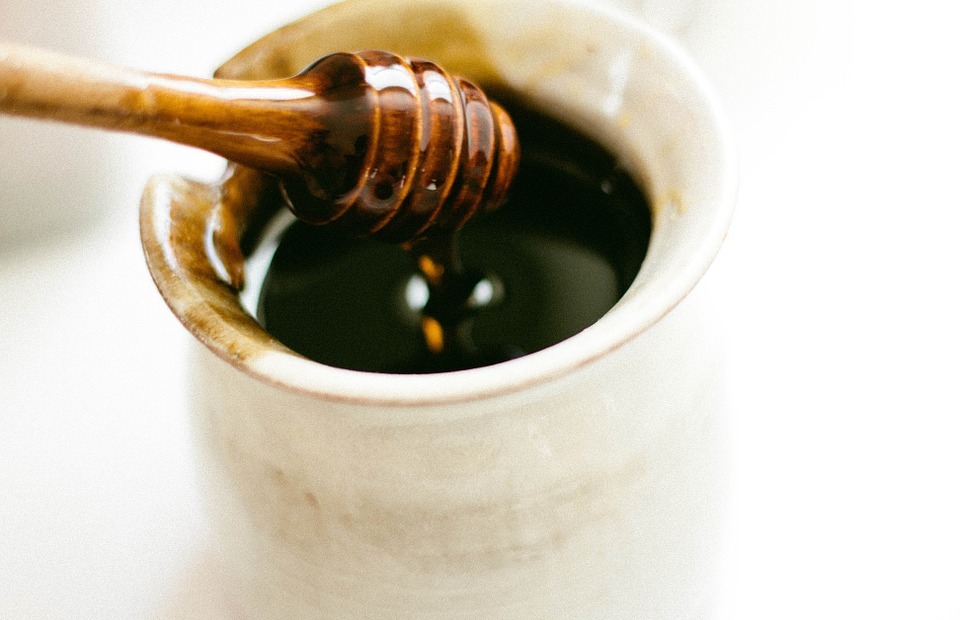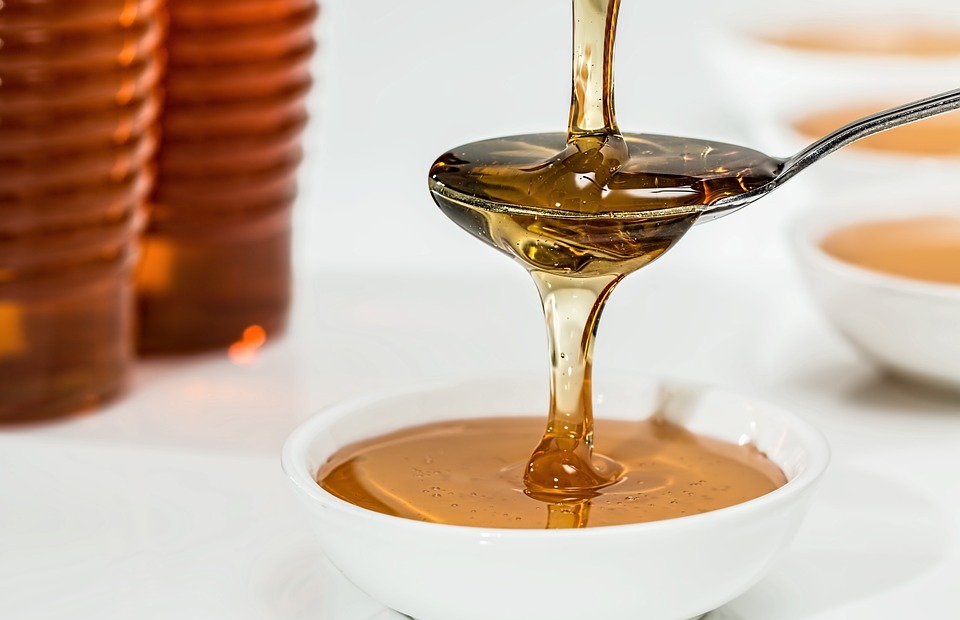Part 1: Honey and its Nutritional Value for Dogs

1.1: A Natural Sweetener with Potential Benefits
Honey, a golden nectar produced by bees, is a natural sweetener with a rich history of use in both human and animal nutrition. Its unique composition offers several potential benefits for dogs, including:- Simple Sugars: Honey provides readily available energy for dogs, especially during periods of increased activity or recovery. These sugars, such as fructose and glucose, are quickly absorbed by the body, providing a rapid energy boost.
- Antioxidants: Honey contains antioxidants like flavonoids and phenolic acids, which can help combat free radicals, protecting cells from damage and supporting overall health. Antioxidants are crucial for fighting oxidative stress, a process that contributes to aging and disease.
- Antibacterial Properties: Some studies suggest that honey possesses antibacterial properties, particularly Manuka honey, which is known for its high concentration of methylglyoxal (MGO). These properties may help soothe minor wounds, infections, and promote healing.
- Probiotics: Certain types of honey, such as Manuka honey and raw honey, contain probiotics, beneficial bacteria that can support gut health and digestion. Probiotics play a vital role in maintaining a balanced gut microbiome, essential for optimal immune function and overall well-being.
1.2: Types of Honey and Their Suitability for Dogs
Understanding the different types of honey is crucial for making informed choices about what's safe and beneficial for your dog.- Raw Honey: This type of honey is unprocessed and retains most of its natural enzymes, antioxidants, pollen, and beneficial bacteria. Raw honey is often considered a more nutritious choice, though it may carry a slightly higher risk of botulism.
- Processed Honey: Processed honey undergoes heat treatment and filtration, which removes pollen and some enzymes. This process reduces the risk of botulism but may also diminish the nutritional value and beneficial compounds.
- Manuka Honey: Originating from New Zealand, Manuka honey is renowned for its potent antibacterial properties due to its high MGO content. This makes it a potential aid in wound healing and infection prevention. It's important to note that Manuka honey can be more expensive than other types.
- Clover Honey: A common and widely available type of honey, clover honey is generally mild and easily digestible, making it a suitable option for dogs. It's known for its light colour and delicate floral flavour.
Part 2: Potential Risks Associated with Honey Consumption in Dogs

2.1: High Sugar Content and Weight Gain
While honey offers potential benefits, its high sugar content presents a significant concern. Excessive consumption can lead to weight gain and related health problems such as:- Obesity: Excess sugar can contribute to calorie overload, leading to weight gain and increased risk of obesity-related diseases like diabetes and heart disease.
- Pancreatitis: A sudden surge in blood sugar can put stress on the pancreas, potentially leading to pancreatitis, a painful inflammation of the pancreas.
- Dental Issues: Sugary treats, including honey, can contribute to the formation of plaque and tartar on teeth, increasing the risk of dental problems.
2.2: Digestive Issues and Diarrhoea
Despite being naturally sweet, honey can still cause digestive upset in dogs, especially if consumed in large amounts. Factors contributing to this include:- High Sugar Concentration: The high sugar content in honey can upset the delicate balance of bacteria in the gut, potentially leading to diarrhoea.
- Individual Sensitivities: Some dogs may have sensitivities or intolerances to honey, resulting in digestive issues.
- Pre-existing Digestive Issues: Dogs with pre-existing digestive conditions, such as inflammatory bowel disease (IBD), may be more prone to digestive problems when consuming honey.
2.3: Botulism Risk (Raw Honey)
Raw honey may contain spores of Clostridium botulinum, a bacterium that can produce botulinum toxin, the cause of botulism. This potent neurotoxin can lead to muscle weakness, paralysis, and even death. However, this risk is primarily associated with raw honey, and processed honey is generally considered safer due to heat treatment that eliminates the bacteria.2.4: Allergies and Sensitivities
While uncommon, some dogs may be allergic to honey. Symptoms of honey allergies can include:- Hives: Raised, red welts on the skin, often accompanied by itching.
- Itching: Excessive scratching, licking, or rubbing, possibly leading to hair loss.
- Swelling: Swelling of the face, lips, or paws.
- Gastrointestinal Upset: Vomiting, diarrhoea, or abdominal pain.
- Difficulty Breathing: Wheezing, coughing, or shortness of breath.
Part 3: Feeding Honey to Dogs: Guidelines and Recommendations

3.1: Start Small and Monitor for Reactions
When introducing honey to your dog, it's essential to start with a tiny amount, no more than a teaspoon. Monitor your dog carefully for any signs of adverse reactions, such as digestive upset, allergies, or behavioral changes. If your dog shows no signs of sensitivity, you can gradually increase the amount over time.3.2: Choose High-Quality Honey
Opt for raw honey whenever possible, as it retains more of its natural nutrients and beneficial compounds. Look for honey that is specifically labelled as "dog-friendly" or "pet-friendly" to ensure it's safe for canine consumption. Additionally, look for honey that is locally sourced and produced without the use of pesticides or herbicides.3.3: Incorporate as a Treat, Not a Staple
Honey should be given as an occasional treat, not a regular part of your dog's diet. Avoid feeding honey in large quantities, as it can lead to weight gain and other health problems.3.4: Consult with Your Veterinarian
Always consult with your veterinarian before adding honey to your dog's diet, especially if your dog has any pre-existing health conditions or allergies. They can provide personalized advice based on your dog's specific needs, including considerations for breed, age, weight, and any medical conditions.Part 4: Creative Ways to Include Honey in Your Dog's Diet
4.1: Honey-Flavoured Treats
Baking dog treats at home using honey as a natural sweetener is a fun and healthy option. Many dog treat recipes incorporate honey to enhance flavour and provide nutritional benefits. Be sure to use dog-safe ingredients and avoid adding chocolate, grapes, or other toxic ingredients.4.2: Honey-Glazed Dog Biscuits
A thin layer of honey can be drizzled over commercially available dog biscuits for a tasty and healthy treat. Choose biscuits made with high-quality ingredients and avoid those containing artificial colours, flavours, or preservatives.4.3: Honey-Infused Dog Yogurt
Plain, unsweetened yogurt can be mixed with a small amount of honey for a refreshing and nutritious snack. Ensure the yogurt is specifically formulated for dogs and doesn't contain added sugar, artificial flavours, or ingredients that could be harmful.4.4: Honey-Drizzled Fruit
A slice of banana or apple drizzled with a touch of honey can be a tempting and healthy treat. Choose fresh, ripe fruit and avoid giving your dog fruit pits or seeds, which can be toxic.Part 5: Honey and Dog Training
5.1: Using Honey as a Positive Reinforcement
Honey can be a valuable tool for positive reinforcement during dog training sessions. Its sweetness and pleasant flavour make it an appealing reward for desired behaviours, encouraging your dog to repeat those actions.5.2: Avoiding Excessive Reliance on Honey
While honey can be a useful training aid, it's crucial to avoid relying on it exclusively. Overuse of honey can lead to overindulgence and potential health issues. Use a variety of rewards, including praise, toys, and other treats, to keep training engaging and prevent boredom.Part 6: FAQs
Q1: Is honey better than artificial sweeteners for dogs?
While honey is a natural sweetener, it's still high in sugar and can lead to health problems if consumed in excess. Artificial sweeteners are generally not recommended for dogs, as many are toxic. It's best to avoid both artificial and natural sweeteners and focus on providing a balanced diet.
Q2: Can I give honey to my puppy?
It's best to avoid giving honey to puppies, especially those under 6 months old. Their digestive systems are still developing, and too much sugar can be harmful. Focus on providing a balanced diet specifically formulated for growing puppies.
Q3: Can I mix honey with my dog's food?
While you can mix a small amount of honey with your dog's food, it's not recommended as a regular practice. It's best to offer honey as an occasional treat. Adding honey to every meal can lead to overindulgence in sugar and potential health problems.
Q4: How much honey is safe for my dog?
The amount of honey safe for your dog depends on their size and overall health. A good rule of thumb is to start with a small amount, no more than a teaspoon, and gradually increase as needed. Consult with your veterinarian for personalized recommendations based on your dog's specific needs.
Q5: What are the signs of a honey allergy in dogs?
Signs of a honey allergy in dogs can include:
- Hives
- Itching
- Swelling
- Gastrointestinal upset
- Difficulty breathing
Q6: Can I give my dog honey to soothe a cough?
Some people believe that honey can help soothe a cough in dogs, but there's no scientific evidence to support this claim. If your dog is coughing, it's best to consult with your veterinarian for a diagnosis and treatment plan. They can recommend appropriate medication or other remedies if necessary.
Q7: Can I give honey to my dog with diabetes?
No, it's not recommended to give honey to dogs with diabetes. Honey is high in sugar, which can worsen blood sugar control and potentially lead to complications. Stick to a diabetes-friendly diet formulated by your veterinarian.
Q8: Can I give honey to my pregnant or nursing dog?
It's best to avoid giving honey to pregnant or nursing dogs. While a small amount might be okay, it's always best to consult with your veterinarian for specific recommendations during these sensitive periods.
Everyone is watching
-

Can Dogs Eat Bananas? A Guide to Safe Treats
DOGS & PUPPIESThis comprehensive guide will delve into the world of canine nutrition, focusing on the popular question: can ...
-

Can Dogs Eat Oranges? (Is It Safe or Toxic?)
DOGS & PUPPIESThis article delves into the question of whether dogs can safely consume oranges. We'll explore the nutrition...
-

Can Dogs Eat Grapes? The Shocking Truth About This Fruit
DOGS & PUPPIESThis article delves into the controversial topic of grapes and dogs, exploring the potential dangers associate...
-

Why Do Dogs Eat Poop? Understanding Coprophagia in Dogs
DOGS & PUPPIESThis article delves into the perplexing phenomenon of coprophagia, the act of eating faeces, in dogs. We explo...
-

Can Dogs Eat Shrimp? A Guide to Safety and Risks
DOGS & PUPPIESThis comprehensive guide dives into the world of shrimp and dogs, exploring the potential benefits and risks a...
